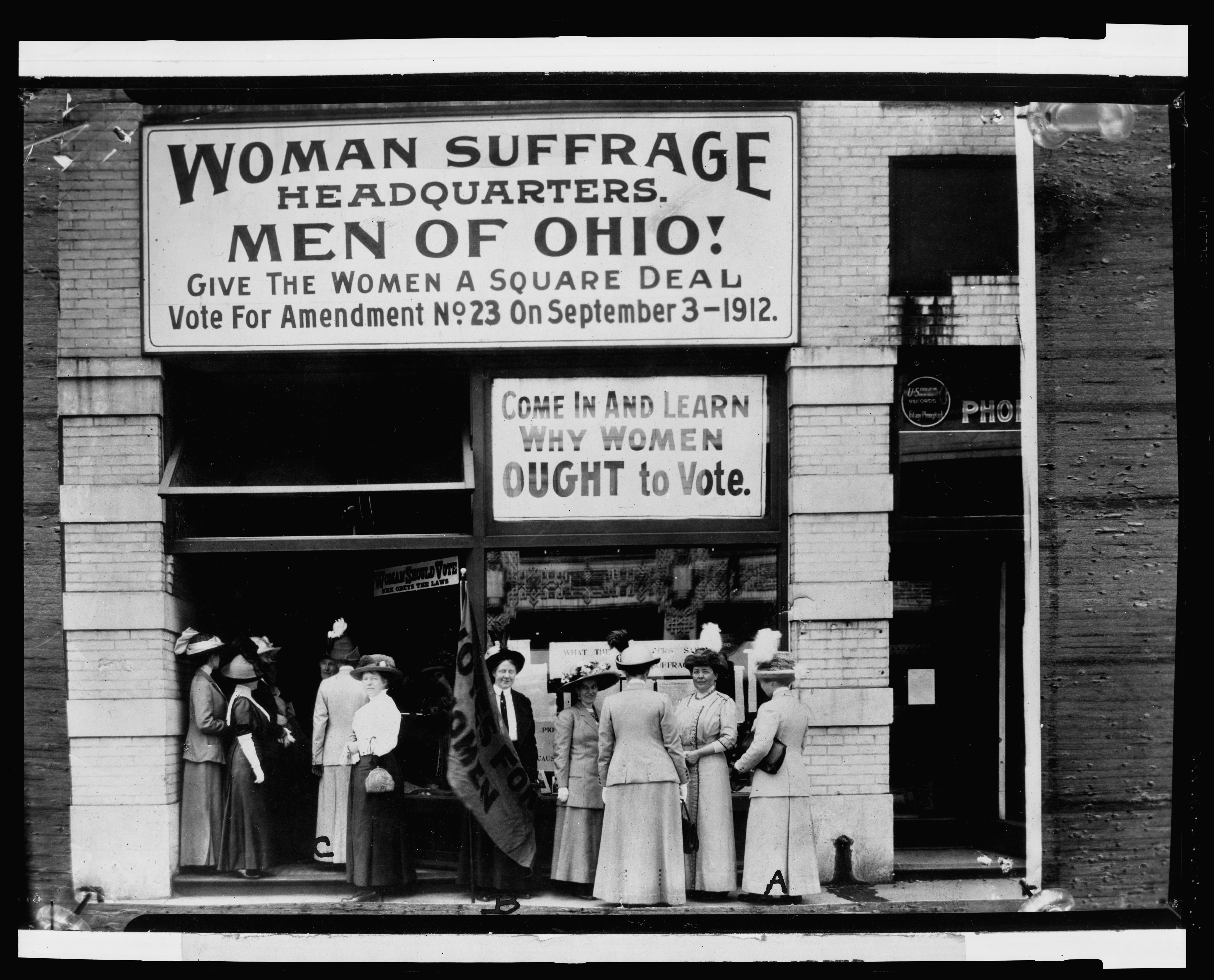 In the photo above, National League of Women Voters members gather at the woman suffrage headquarters in 1912 in Cleveland, Ohio. (Photo courtesy of the Library of Congress)
In the photo above, National League of Women Voters members gather at the woman suffrage headquarters in 1912 in Cleveland, Ohio. (Photo courtesy of the Library of Congress)The 19th Amendment to the U.S. Constitution guaranteeing women the right to vote was ratified by the states Aug. 18, 1920. During the 100th anniversary year of women’s suffrage, DePaul faculty Christina Rivers and Amy Tyson sat down with Newsline to discuss the significance of the movement, its relevance today, and the work still left to be done.
 Christina Rivers is an associate professor of political science in the College of Liberal Arts and Social Sciences. (DePaul University/Jeff Carrion)
Christina Rivers is an associate professor of political science in the College of Liberal Arts and Social Sciences. (DePaul University/Jeff Carrion)
Christina Rivers is an associate professor of political science in the College of Liberal Arts and Social Sciences and an
inaugural Presidential Fellow. She is an expert on race and representation in the U.S., African American politics and political thought, and civil and voting rights law.
How did the women’s suffrage movement fall short, and how is that still felt today?
By some historical accounts, the women’s suffrage movement fell short almost right off the bat. For the first couple of decades, women really sat on their right to vote. It’s not that they didn’t vote, but they didn’t vote in ways that would lead to them running and being elected to office. It wasn’t until the 1960s that women started to talk more about utilizing their right to vote as well as their voice to improve their positions in the domestic and public spheres. To an extent, this is still felt today where it’s nice to have the vote, but it only means so much when women are still so profoundly underrepresented in legislative and other elected bodies. Had someone told me if I were alive in 1920 that in 2020 there would still be this disproportionality across all levels of government, I’m not sure if I would have believed them.
Are there any populations in the U.S. still fighting for the right to vote?
African Americans, Latinx, Native Americans, students and citizens who are in jail or who have had a felony conviction are all still fighting for the right to vote. We are facing a new wave of voter suppression. The most recent tactics we’re seeing are voting purges, which isn’t a new practice and not necessarily always a problem. It is premature purges however, or those with a strong racial disproportionality, that are an issue. Another issue with voting includes the accessibility of precincts, the shortening periods of early voting, and voter ID laws, all of which disproportionately affect people of color. Some voter ID states make it especially difficult for students to vote. Those, for example, that don’t accept student IDs instead of official states IDs, knowing students struggle with the time or money to get a state ID. Native Americans have experienced voter purges and redistricting issues in the past 10 years or so that have had a very damaging effect on their ability to vote and be represented.
Finally, states disenfranchise those with a felony conviction to varying degrees, and in some cases the disenfranchisement is effectively permanent. While Illinois restores voter eligibility to people upon their release from prison, many formerly incarcerated citizens are not aware of this, and think that they are permanently disenfranchised. Similarly, the vast majority of citizens in jail awaiting trial are eligible to vote. But most don’t know this, and virtually none of them have access to the ballot while detained. In 2019, Illinois became the first state to mandate voter access and education for those in its jails and prisons, and we hope that other states will follow suit.
 Amy Tyson is an associate professor of history and American Studies in the College of Liberal Arts and Social Sciences. (DePaul University/Jeff Carrion)
Amy Tyson is an associate professor of history and American Studies in the College of Liberal Arts and Social Sciences. (DePaul University/Jeff Carrion)
Amy Tyson is an associate professor of history and American Studies in the College of Liberal Arts and Social Sciences. Tyson is an expert on 19th and 20th century U.S. social and political history.
What is the significance of the women’s suffrage movement?
The history of women’s suffrage shows the organizing power of women at a time when it was no small task to convince the nation that women should enter the political fray. To draw attention to their cause, suffragists staged massive parades, picketed the White House, lobbied state and federal legislatures, faced arrest on charges like obstructing traffic, and some even staged hunger-strikes from inside their jail cells.
In what ways did the women’s suffrage movement fall short?
After the passage of the Reconstruction amendments, which outlawed slavery, and enfranchised male citizens regardless of race or previous conditions of servitude, the suffrage movement was increasingly divided by race. The nation’s largest suffrage organization, the National American Woman Suffrage Association, largely dismissed black women’s particular concerns. They instead aimed to pass state by state woman suffrage amendments through adopting what was known as the Southern Strategy. This appealed to Southern states by enfranchising white educated women and thus strengthening white supremacy.
What improvements need to be made today regarding voting rights?
While the 19th Amendment did extend the franchise to millions of female citizens, little changed in terms of voting rights for Southern black women until the passage of the 1965 Voting Rights Act. Key provisions of this act were struck down in 2013, in a 5-4 U.S. Supreme Court ruling (Shelby County v. Holder). What followed has been a continuing wave of voter suppression measures most often targeting minorities in states across the country. As we contemplate the significance of the 19th Amendment 100 years out, there is no better time to support the ongoing fight to ensure voting rights protections, but this time, for everyone.